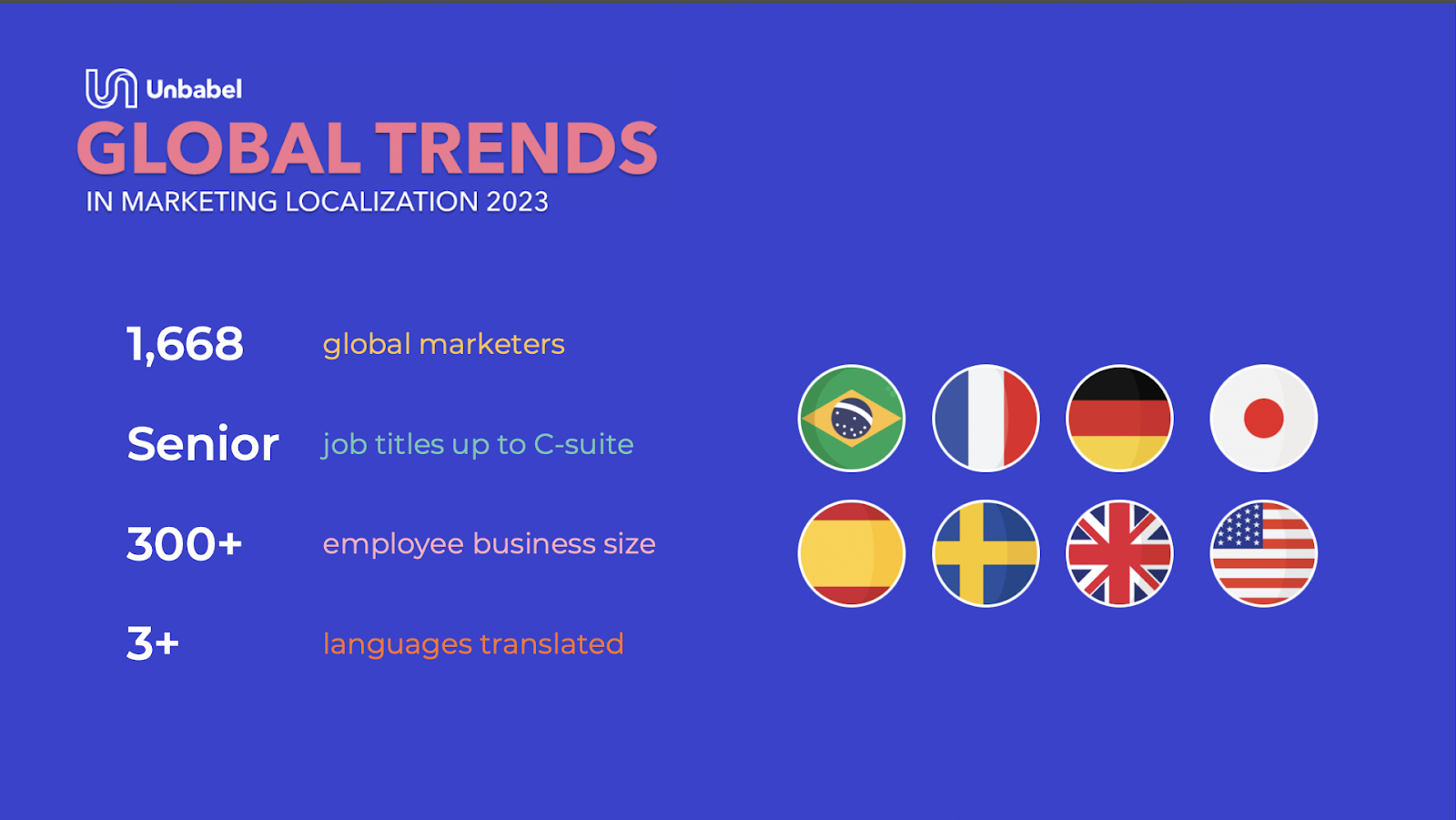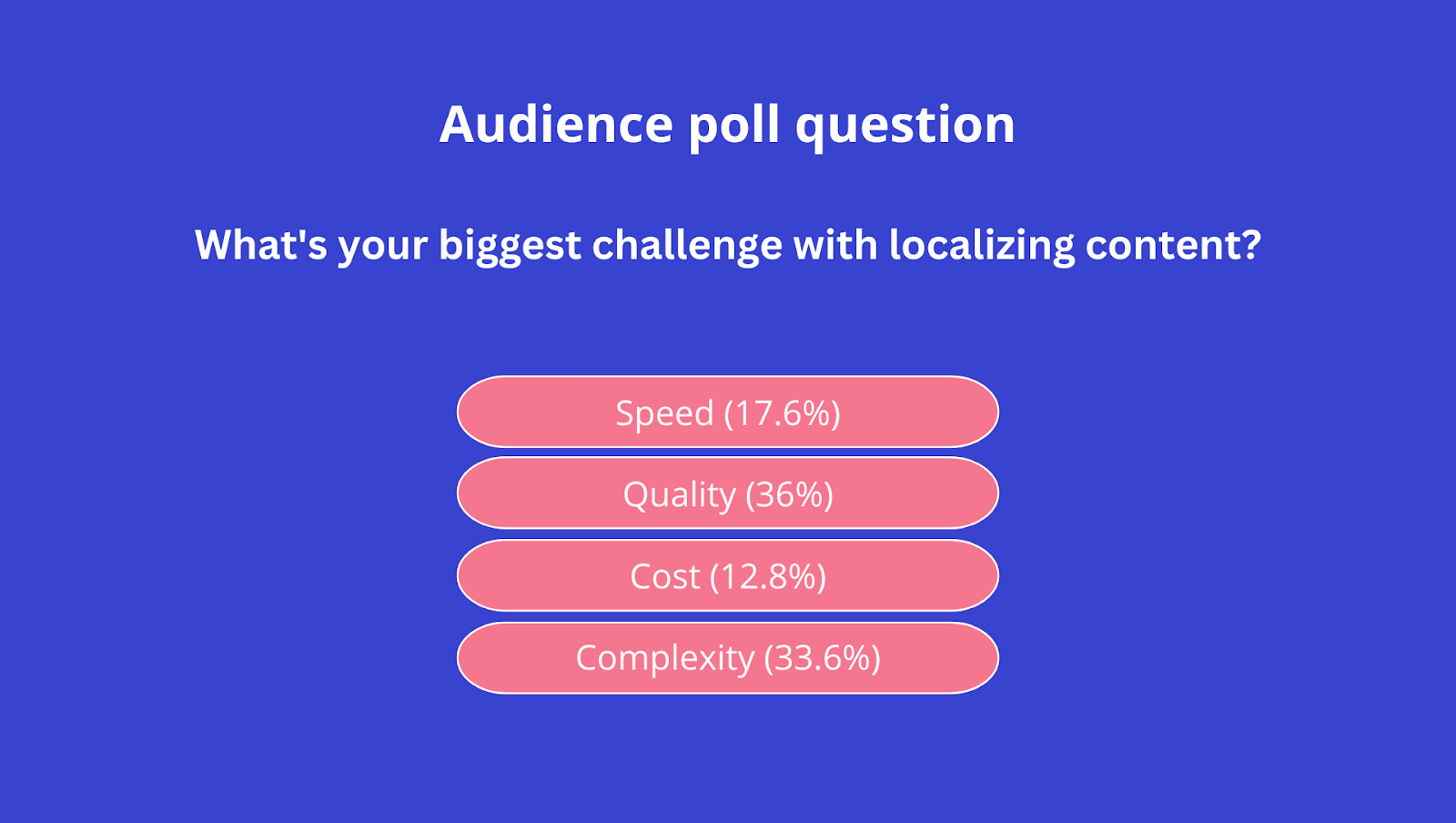
Branded content is critical for companies making connections with their customers, and it’s vital for the conversion process. But, as you move into more markets, there’s a challenge: Delivering multilingual branded content at the right quality at speed and scale.
Content marketers in particular are under pressure to produce more content across more channels, and when you’re doing this across international markets, in multiple languages, the complexity can really add up. How are marketers getting to market first and handling the challenge of localizing their branded content at scale?
Val Swisher, Founder and CEO of Content Rules, joined Phill Brougham, Director of Product Marketing at Unbabel, to discuss all things new in marketing localization, including fresh new data from Unbabel’s Global Trends in Marketing Localization Report 2023 — hosted by Stephanie Stahl at the Content Marketing Institute.
Here, we share their discussions on business investments in localization and how marketers are measuring the quality of their multilingual marketing content.
Global Trends in Marketing Localization Report 2023
The report, shared Phill, aimed to get into the mind of global marketers and how they’re overcoming these localization challenges while they scale their global content marketing strategies:
What are the strategies they’re employing?
What are the challenges they’re facing? What’s working?
Audience breakdown

Download the report to read the full audience breakdown plus six pivotal trends about the future of content localization:
Marketers are investing in translation and localization
Marketers are embracing Machine Translation, and it’s delivering the quality they need
Translation quality is the number one challenge for marketers
Highly manual localization processes are affecting quality for marketers
Localization is driving revenue growth and other business goals
Companies in the early stages of Language Operations are seeing higher quality
Why are companies investing in localization?
It’s become obvious, reflects Val, that to increase your footprint worldwide, you can no longer deliver English to everyone. Val urges companies to start reaching out beyond the usual eight languages to capture different markets for a truly global audience.
Indeed, shares Phill, 57% of consumers felt that it was a bias if brands did not serve a multilingual customer experience. Not only do consumers feel unaccommodated, but they can almost feel insulted as if the company is somehow against them or their language or market.
Unbabel’s Global Marketing Localization Report revealed that one of the reasons companies are investing more in translation and localization is because the investment is actually paying off. In this positive reinforcement loop, 84% of the marketers surveyed said that localization is having a positive impact on revenue growth. Beyond the top line, 86% said it has a positive impact on their brand recognition, and 85% a positive impact on customer acquisition.
“84% of the marketers surveyed said that localization is having a positive impact on revenue growth.”
Where to invest?
Val’s experience suggests that if companies can get their multilingual content needs met for less money than in their localization and translation budget, teams don’t give the budget back, but reinvest it into either localizing and translating more content or across different languages and into new markets.
“When companies get their multilingual content needs met for less money than in their budget, teams reinvest it into either localizing and translating more content or across different languages and into new markets.”
More companies are investing in machine translation (MT) because it has gotten so much better, says Val. Now, companies can translate their content, and more content, more quickly, better, and for cheaper. Again, it’s another positive reinforcement loop, with more money invested in MT.
The better the technology gets, notes Val, the more languages companies want to translate, the easier it is to translate into more languages, and the more money companies spend.
“We’re really seeing this momentum and it’s partly driven by this acceleration of MT quality, in terms of linguistic quality. But, these initiatives can be victims of their own success: The marketing team needs to keep pace with the growing volumes of content, channels and languages and deal with the complexity of taking foundational pieces of content from English and adapting them to twelve or so markets.”
Localization budget: Where does it sit and who controls it?
It depends, say both Phill and Val. Large organizations almost always have a localization department, not necessarily translators, who run and coordinate localization as a department. They will have a certain amount of budget to spend. For others, the marketing team or content marketing team in particular might be the ones looking after the localization budget.
The third place the localization budget sits is under regions: Here regions aren’t necessarily using it to localize and translate, but to transcreate. Transcreating is when that region creates its own content, written for that market, which may not exist outside of its region. To get this right, and avoid organized chaos, shares Val, there’s some management needed. This really depends on the company: Some companies are very HQ central and want to control everything. Others are more dispersed, giving the regions more free reign over their market and their own budget, so they can do what they need.
What’s the biggest challenge that you are facing with localizing content?
Phill polled the audience, asking one of the questions from the Unbabel Global Marketing Localization Report, to find out what was the biggest challenge with localizing content. The CMI audience (36%) noted quality as their biggest challenge, similar to the (23%) from the Unbabel survey.

Seven years ago or so, cost would have been much more of a factor, stated Val. Yet, she noted that the more businesses translate and localize, the more they realize how complex it can be and see issues around quality. “It doesn’t surprise me that quality is the number one challenge. Nor, that complexity is number two. As you add languages, your complexity does not multiply, it exponentiates. If you add four languages, your complexity is not x4 of what it used to be, it’s to the power of 4 of what it used to be,” says Val.
“As you add languages, your complexity does not multiply, it exponentiates. If you add four languages, your complexity is not x4 of what it used to be, it’s to the power of 4 of what it used to be.”
Quality is the number one challenge
“It doesn’t surprise me that quality is the number one challenge.”
Val says there are two different ways of thinking about quality. The first is the linguistic quality and the second is the effectiveness of the content:
Linguistic quality: This is judged on the technical aspects of the translation or localization: Are the words correct? Was the right image used for the cultural differences in that location?
The effectiveness of the content: This is harder to gauge. It’s about assessing whether the content is the right quality to do what it’s supposed to: If it’s translated ToFu content, are the customers moving through the funnel as needed?
Quality is like two sides of a coin, they’re both really important: You can’t have effective translated content if the linguistics is poor, because your customers will laugh at you and move on to your competition.
As a business, Unbabel tries to make predictions on quality, it’s part of the technology, shares Phill. But it’s such a subjective notion: How do you determine what the quality of something is? Unlike things like speed and cost which we can measure and have associated metrics, quality is much harder to put a figure on.
“Unlike things like speed and cost which we can measure and have associated metrics, quality is much harder to put a figure on.”
If you go to a website, or even more high-risk, you go to make a payment and the translation is poor, you’re unlikely to input your credit card details. Linguistic quality is very important, that said there’s a fine line where you can make a few mistakes in linguistic quality yet still meet your intended objective of making a connection with a customer. “In day-to-day life, we’re probably not communicating with full linguistic accuracy, but it’s really about how you map that linguistic quality to the global business goals,” says Phill.
“In day-to-day life, we’re probably not communicating with full linguistic accuracy, but it’s really about how you map that linguistic quality to the business goals.”
That said, it only takes one error to turn off a consumer completely, and it doesn’t necessarily have to be language quality. There were some great questions from the audience, and one member asked after non-text quality issues: “Do you ever witness difficulties in translation and localization for companies with audiences who rely on emojis in their communication?”
Emojis are good for connecting with audiences, but they can be a double-edged sword, notes Phill.” A picture can speak a thousand words, but have you selected the right picture, and is it speaking the words you think it’s speaking in this other culture?” More and more companies are using emojis and expanding their image-based vocabulary, but they need to have a real understanding of the effect of emojis and meaning across different regions and whether or not the customer demographic is emoji friendly. Indeed, shares Phill, Unbabel has recently launched an emoji test to help companies assess their global emoji knowledge.
Measuring quality — how it’s happening and how it should be
Phill and Val unpicked how global marketers surveyed in the Unbabel Report were measuring quality in practice. The report showed that there are four key ways marketers are measuring the quality of localized and translated global content:
52% of respondents said that they rely on internal colleagues who speak the language. But, says Val, aside from taking the internal reviewer away from their actual job, it’s not a scalable approach to translation, as they can’t keep reviewing ad Infinium. Moreover, internal reviewers might not have an appreciation for brand voice, and key terminology could be skewed due to the personal preference of the reviewer.
28% that they’re using an independent third-party language provider to review their translations, and this can be on top of the initial translation work. This solution requires deep pockets, and it can be time-consuming. As such, shares Phill, it’s unlikely to be covering every single translation that you’re going to make across your blog, website, white paper, or other content types.
43% are using engagement analytics by unpacking key business metrics and KPIs to test the efficacy of the translation. The downside to this approach is that it only measures one thing so it is unlikely to provide all the information you need. For example, if you’re measuring click rates you can’t be sure if poor click rates are due to the translation or some other factor like design, target audience, or keyword.
27% are using quality estimation tools, which can give them some data on the quality of the translation and how it is delivered.
The report shows that currently marketers aren’t leveraging an end-to-end approach as well as they could, and there’s little standardization. Global businesses are spending so much money on developing messages, content creation, content management, and content distribution, and are aware that it contributes to the wider business goals. They simply lack formal ways of verifying it.
Takeaways
Localization is paying off — even if marketers don’t have a clear approach to prove this when it comes to quality. Luckily, Phill and Val shared five key takeaways for marketers looking to deliver great content to local markets on a global scale.














